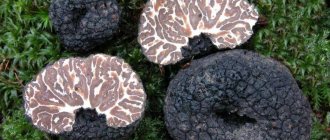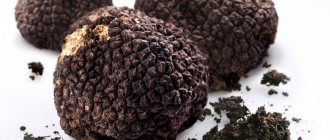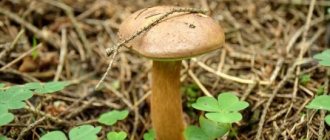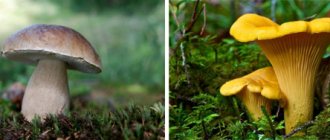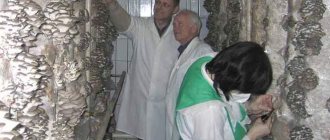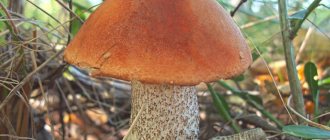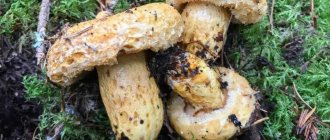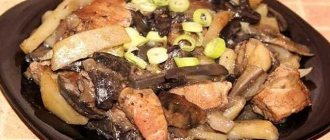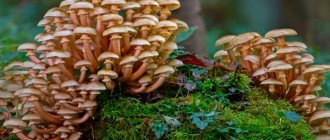And although the cap of this mushroom is bright orange, “hunting” it is not the easiest task. Even experienced mushroom pickers call this forest dweller the mushroom of good luck. Can't guess which one we're talking about? This is a boletus. A basket of these red-hatted beauties is valued almost as much as porcini mushrooms, and they also have more than enough beneficial properties.
Why “boletus”?
The scientific name of this mushroom is Leccinum aurantiacum. But in everyday life it is known as the aspen boletus, since attentive lovers of “quiet hunting” have noticed: more often than not, this beauty is found under aspen trees. Although you should not be surprised if you are lucky enough to find it under spruce, pine, birch, oak, in coniferous-deciduous forests and even on the edges or clearings in groups or alone. True, there are representatives of some varieties that differ from their “brothers” from under the aspens.
Content:
- Why “boletus”?
- Varieties of boletus
- Classification by type
- Seasonal classification
- False boletus
- Beneficial features
- Medicinal properties
- Cautions
- Use in the kitchen
- How to grow in the garden
This type of mushroom is common in Eurasia and North America, in temperate forests. Found in shady thickets, on moist soil. These beauties love to hide among blueberries, ferns, mosses and grass, although sometimes their bright caps are visible along forest paths.
The classic boletus is a mushroom that resembles a boletus, but with an orange-red cap (up to 20 cm in diameter), a stocky stem and dense flesh. It reaches its largest dimensions on the 10th day of growth, some specimens grow up to 2 kg. A distinctive feature of a young mushroom is a hemispherical cap, the edges of which are pressed tightly against the stem. The skin on the cap is not sticky, like butterfish, but dry, in some it is velvety. The club-shaped leg in adult boletuses reaches 22 cm. It is easily recognized by its small black or brown scales. The “hunt” for boletus lasts from the beginning of summer until October.
Because of its bright cap, in the old days it was called by many other names: red mushroom, redhead, krasnik, obabok, chelish. Some suggest that the mushroom got its name also because the color of the cap resembles the bright autumn leaves of aspen.
Growing at home
Boletus is grown at home using ready-made grain mycelium or a self-prepared mushroom suspension. The planting site should be shady and protected from adverse weather conditions. It is necessary to have trees with which the selected boletus species forms mycorrhiza.
If there is ready-made mycelium, it is poured into a hole 30 cm deep and 2 m2 in area. First, the bottom is covered with aspen leaves or sawdust and soil, which also needs to be dug up from under the aspen. Both layers are 10 cm each. Mycelium and regular soil are poured on top.
Boletus mycelium
The suspension is prepared from overripe boletuses, namely the tubular layer. It is finely crushed and mixed with rainwater in proportions of 2:10. Ordinary yeast is also added to the mixture, after which it is aged for about 2 weeks. The suspension is also poured onto the bed according to the same principle as the mycelium.
The area with mycelium or suspension is regularly watered, as mushrooms need plenty of moisture. The first fruits appear a year after planting. It is important not to damage the mycelium when carefully collecting boletus mushrooms.
If you find an error, please select a piece of text and press Ctrl+Enter.
Varieties of boletus
And now - about the varieties. As already mentioned, science knows several species of Leccinum aurantiacum. Some of them are edible, and some can cause serious harm to humans. Although the latter are, of course, no longer real boletuses, but their false doubles.
The first sign of boletus is a red-orange cap and a white leg with dark scales, like a boletus. But it is not uncommon to see white boletuses, which are found in spruce forests, and yellow-brown ones, the “residents” of mixed plantings. White and pink boletuses grow on the damp soils of the forests, and gray ones grow under the poplars.
Another ability of boletuses is to change the color of the stem when cut. The initially white flesh, after damage, changes color to pink, then dark blue or black. And this shouldn't be scary. The fact is that the mushroom contains components that oxidize upon contact with air and enzymes. But such a reaction does not in any way affect the nutritional characteristics and taste.
Still have doubts about the edibility of the mushroom? It's time to look under the hat.
All representatives of the boletaceae family (including aspen boletuses) have a thick porous layer (up to 3 cm) under the cap. As a rule, it is light in color: white, with a yellow-brown or gray tint.
Classification by type
At first glance, it may seem that all boletuses are similar. But experienced mushroom pickers know that this is not so. And different species have their own distinctive features.
Red boletus
This edible mushroom is found under deciduous trees: aspens, birches, beeches, poplars, willows, and oaks. It is small - up to 15 cm in height and with a cap about 10 cm in diameter. The caps of these representatives are bright red or red-brown, the scales on the stem are gray-white. It grows in Europe, Siberia, the Far East and the Caucasus, in the tundra it is found under dwarf birch trees.
Yellow-brown boletus
Other names are red-brown or multi-skinned obabok. A fairly large representative of forests - it can reach 25 cm in height, with a cap diameter of up to 15 cm. The caps are yellow-brown or sandy-orange in color, the legs are usually gray with frequent granular scales of brown-black color. This species is common in temperate forests. Myceliums are found near birch, aspen, and pine and spruce-birch forests.
White boletus
A distinctive feature of young mushrooms is a white cap, which, however, with age reaches 25 cm in diameter and darkens to a gray-brown color. The leg is white, with the same scales. Few people are lucky enough to find such a mushroom. If desired, you should look for it on the moist soils of spruce-birch forests, under aspen trees. Geographically distributed in North America, Western Europe, Siberia, the Baltic countries, and some regions of Russia.
Oak redhead
It resembles boletus mushrooms more than other varieties. Grows in the shade of oak trees. It can be recognized by its coffee-brown cap with orange tints and a stem covered with reddish-brown scales. These mushrooms are quite common in the northern hemisphere - in temperate forests.
Boletus with painted legs
This representative resembles ordinary boletuses less than others. Its cap is often flat and pink in color, uncharacteristic for redheads. The leg is covered with the same scales (or red). Distributed in the eastern regions of North America and Asia, in deciduous and coniferous forests.
Redhead pine
This is an edible mushroom with a dark crimson cap and a stem covered with brown scales. Its height and cap diameter rarely exceed 15 cm. It should be “hunted” in the humid spruce and pine forests of Europe. Experienced mushroom pickers advise, first of all, to carefully examine the base of pine trees and thickets of bearberry - this is where the redhead hides most often.
Black-scaled boletus
It is not difficult to recognize this mushroom. Its cap is brick, dark red or orange, and its leg is dotted with reddish scales. Distinctive feature: the white leg quickly turns purple or gray-black after damage.
Spruce redhead
A small representative of the boletus family with a chestnut cap and a cylindrical stem with light brown scales. Rarely found alone. Mycelium grows in all coniferous forests, but best under spruce trees. Sometimes found in mixed forests.
Paintedfoot
It stands out noticeably from others in appearance. It has a large convex or almost flat cap of a pink-brown hue. The leg is creamy pink, covered with red or pink scales.
Interesting: Boletus - description, what it looks like, where it grows, when to collect, varieties, photos and videos
Painted-legged boletus
At the very base it turns yellow. The colored-legged boletus begins to bear fruit at the end of May and ends in August. Grows with both deciduous and coniferous trees.
Interesting fact : for some reason, this particular species attracts insects, so very often the mushrooms you come across are wormy.
Seasonal classification
The fruiting season for boletuses is very long. And the summer representatives are somewhat different from their October “brothers”.
People noticed these features a long time ago, which is why they divided mushrooms into three seasonal groups.
Kolosoviki are boletuses that appear at the end of June and disappear at the end of the first ten days of July. These are the very first mushrooms, of which there are usually few. During the indicated period, yellow-brown and white boletuses are found.
Reapers - appear in mid-July and bear fruit until the end of August - beginning of September. This is the “star” time of red boletuses, oak boletuses, and black-scaled boletuses.
Deciduous mushrooms are the last mushrooms to appear in the second half of September. Until the first frost, you can “hunt” for redheads in pine and spruce forests with rich coniferous litter, which protects the mushrooms from the cold.
False boletus
In addition to the fact that boletuses are one of the most beautiful, tasty and healthy mushrooms, they are also one of the safest forest gifts.
Despite the impressive number of varieties, these mushrooms are practically never poisonous. But novice mushroom pickers still often wonder what a false aspen boletus looks like. However, more experienced ones assure: there are no false redheads in nature. The only problem is that, due to inexperience, some people mistake bitterling (gall mushroom) for boletus. You can identify “false boletus” by the characteristic brown mesh on the stem (instead of scales), pink or brown spots on the cut, and a bitter taste.
Many titles
The boletus mushroom is one of the most common and favorite mushroom gifts of the forest. This is a representative of the genus Leccinum. Has several names.
People may call it as aspen, obabok or redhead. Less commonly referred to as red mushroom or red mushroom.
In some regions it is called red cap, krasnik or vanka-vstanka.
Beneficial features
Mushrooms are called vegetarian meat.
And all because this type of product, and boletus is no exception, contains extremely rich reserves of proteins. It is interesting that the human body absorbs proteins from boletus almost completely – 80%. Therefore, this mushroom is an unrivaled source of amino acids and other nutrients important for the restoration of weakened organisms.
Boletus is a good source of fiber, carbohydrates and healthy fats. They contain vitamins A, B, group B, as well as impressive reserves of iron, potassium, magnesium, calcium, phosphorus, and sodium. Interestingly, boletus contains B vitamins in almost the same quantities as cereals, and the reserves of vitamin B3 (nicotinic acid) are similar to the concentration in yeast or liver. Some studies prove the anti-cellulite properties of mushrooms.
In percentage terms, the composition of boletus mushrooms looks something like this:
- 90% – water;
- 4% – proteins;
- 2% – fiber;
- 1.5% – carbohydrates;
- 1% – fats;
- 1.5% – minerals and vitamins.
Boletus belongs to the category of dietary food. 100 grams of product contain no more than 44 kcal, and a zero glycemic index makes them safe for people with diabetes and obesity. Laboratory studies have proven that boletuses are good at cleansing the body of toxins and toxic substances. The broth made from these mushrooms is an extremely nutritious product that is often compared to meat broth. For this reason, mushrooms are recommended to people after surgical operations, severe protracted illnesses, to strengthen the immune system. But it is still worth noting that most of the useful components are concentrated in the mushroom cap, while the stem is relatively poor in nutritional components.
Medicinal properties
Even in ancient times, people noticed that mushrooms are not only tasty, but also healthy. More than two thousand years ago in Ancient China, mushrooms were used as an effective remedy. Various ailments were also cured with this product in Rus'. And some of the mushrooms were valued even more than medicinal herbs.
Honey mushrooms, for example, helped treat intestinal disorders, mushrooms, chanterelles and milk mushrooms - colds and infectious diseases, boletus - headaches, raincoats quickly healed wounds, and boletuses were used to cleanse the blood.
Modern researchers who have created a science that studies the healing properties of mushrooms - fungotherapy - do not forget about the healing properties of mushrooms.
Contraindications
Despite the large amount of useful substances in their composition, these mushrooms are more capable of accumulating toxins from the soil than other species. You should not use overgrown mushrooms, or collect them near highways, big cities and industrial enterprises.
The product is heavy, so in case of kidney and liver failure it can cause harm to the body. Also, this mushroom should not be eaten by children and people suffering from individual intolerance to the components of this type of mushroom. To avoid botulism, it is cut higher, leaving part of the stem in the ground.
Cautions
And although mushrooms are considered a healthy product, it is still important to use them with caution for people with kidney disease or impaired liver function.
Mushrooms grown along roads and in contaminated areas are dangerous, since their spongy bodies easily accumulate carcinogens and toxins. It should be remembered that improperly prepared mushrooms (undercooked) cause botulism. And once again: the right boletus will never taste bitter.
Use in the kitchen
Boletuses are one of the most delicious mushrooms. They taste like boletus mushrooms, and they are known to be the best after the porcini mushroom.
There are many ways to prepare this forest delicacy. They are suitable for boiling, frying, drying, pickling and pickling. But with almost any harvesting method, the mushroom loses its bright color. The exception is pickled boletus, which retains the beauty of its colors. But so that the mushrooms do not darken so much, they are soaked in acidified water.
Many recipes use whole mushrooms, although some gourmets avoid the stems, considering this part to be tough. But in any case, it is important to prepare fresh mushrooms as quickly as possible after picking, since they spoil in a matter of hours. The easiest way is to boil the boletus. Young mushrooms reach full readiness within 20 minutes after boiling. It will take longer to fry - from half an hour to 40 minutes. They are also suitable for freezing. Both raw, peeled and slightly cooked ones are stored well in the freezer for several months.
For longer storage, mushrooms can be dried. But it is important to follow some rules. Firstly, boletus mushrooms should never be washed before drying. Their spongy body quickly absorbs water, which can no longer be gotten rid of. Fresh delicacies must be thoroughly cleaned of branches, leaves, insects, and soil (soft brushes are suitable for this), then cut large ones into pieces, and leave small ones whole. There are several ways to dry. If you give preference to oven drying, then it is important that the temperature in the cabinet does not exceed 50 degrees. Place a baking sheet with parchment and mushrooms on the top shelf - this way the mushrooms will not burn. To ensure uniform drying, stir the contents of the pan from time to time, especially if you are preparing a large portion of the delicacy.
How to prepare and store?
Boletuses tend to deteriorate very quickly, so they are processed immediately after collection. Prolonged stay in water is harmful due to the accumulation of excess moisture.
Boletus is a universal mushroom in terms of harvesting and cooking.
After a half-hour soaking procedure, the mushrooms are thoroughly cleaned of dirt and possible wormy areas. Redheads can be prepared and stored in any convenient way: dried, pickled, frozen, boiled and fried.
